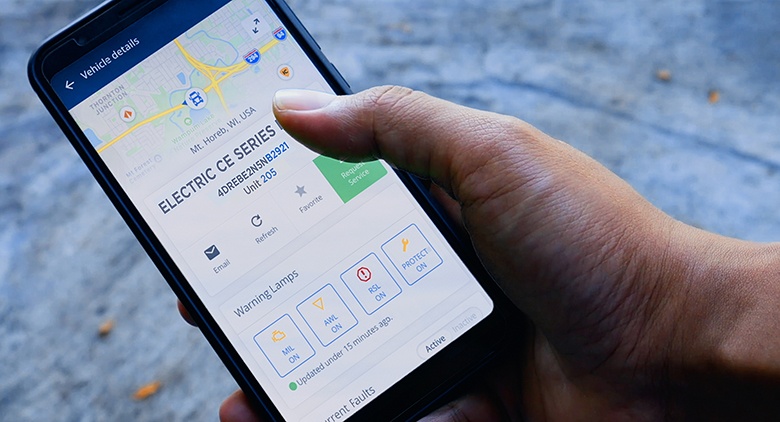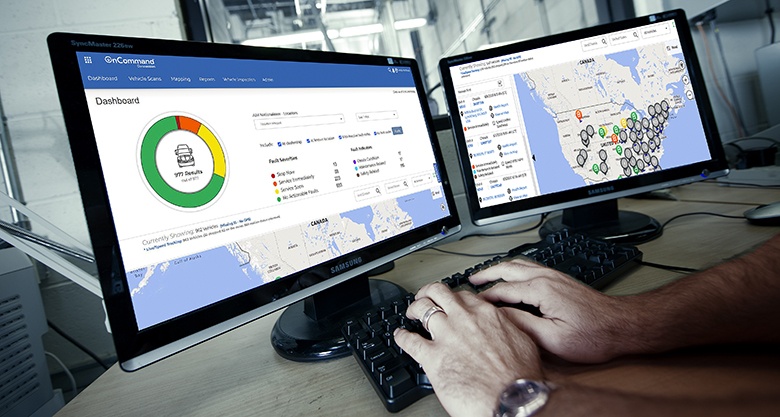
IC Bus® says its OnCommand® Connection remote diagnostics tool is a game-changer for pupil transportation
As people, vehicles, and transportation systems become more “connected,” school bus manufacturers are keeping pace with technology to help supervisors increase oversight and reduce unplanned downtime.

For its part, IC Bus has introduced Navistar’s OnCommand Connection (OCC) remote diagnostics for school districts and school bus operators. OCC originally launched in 2013, as Navistar recognized an opportunity to leverage technology to monitor vehicles remotely, allowing transportation staff and maintenance supervisors to begin diagnosing vehicle health issues while they are still on the road.
“Before OCC, customers would just see an ambiguous check engine light and bring their vehicle into service for diagnosis before the nature of the issue could be identified,” said Matthew Milewski, connected vehicle marketing director at Navistar.
Early diagnosis has many benefits, including helping transportation departments understand when a vehicle fault might be minor and able to wait until its next scheduled service. Conversely, it can alert them if a health issue must be addressed immediately to avoid a more expensive repair or even a roadside failure in the future.
“The adoption of this technology saw a significant increase in on-highway truck applications when electronic driver logs became federally mandated,” Milewski said. “But the importance of a healthy, reliable, and safe fleet of vehicles is just as important, and you could argue even more important, when we talk about student transportation.”
Not only do school bus fleets want to know that their vehicles will be able to complete their routes safely and efficiently, Milewski said, but the insights of OnCommand Connection can help them reduce unplanned downtime and optimize their preventive maintenance spending as well. In addition, school bus fleets see value in being able to use the data for the ability to do things like recreate previously completed bus routes to check road speed, timing of doors opening and closing, and other events during the route.

Always Connected
IC Bus said that solutions like OCC help boost uptime and reduce total cost of vehicle ownership, by providing fault code reporting and severity ratings, vehicle health reports, fault code action plans that identify most likely needed parts and service, on-hand inventory of needed parts at the closest IC Bus dealer, and GPS mapping to nearby service centers.
Available for any make of bus, districts can access this information through the interactive OCC Go mobile app, a desktop interface, and even through custom email reports. Furthermore, the system can directly interface to other fleet management solutions – making full-fleet oversight as seamless and easy as possible.
IC Bus offers multiple channels of support to districts using OnCommand Connection, Milewski said.
“It starts with their dealers, as they have the closest relationship with the district,” he said. “The connected tech expert at each dealership is a great resource for enrollment, training, and troubleshooting for customers. We have online tutorials and PDF guides available for self-training, and there are also support resources in the field and at Navistar HQ whenever needed.”
Ty Stacy, head of bus sales at Roberts Truck Center in Albuquerque, New Mexico, said that the level of connectivity provided by OCC has been invaluable for dealers. Stacy said that from 2020, Roberts has elected to have OCC pre-installed on every bus sold from the dealership.
“It virtually allows us to bring our garage into their bus barn,” he said. “We can see what we need to see from our location. We can advise them; if they’re capable of the repair we can get them onto the repair tree and get the parts out to them. If they’re not, it provides more service and parts for us.”
 Enrollment and Training
Enrollment and Training
Enrollment in OCC is very simple, Milewski said. A district’s local dealership is able to help them set up an account when they take delivery of a vehicle with factory-installed telematics.
If a district has existing buses with telematics from a third-party provider such as Zonar, they can also set up an account and view those buses in OCC at no charge as well.
“We also support customers in a number of ways, depending on how they want to manage their account,” he said. “We have online tutorials on using the dashboard, and our dealers can also help customers set up regularly scheduled reports to their email inbox if they prefer to keep eyes on their fleet that way.”
IC Bus dealers also have what the company calls designated “connected tech experts” to support the sales team and districts during the enrollment and onboarding process.
“The logistics of installation are extremely simple and the dashboard is very easy to use,” said Stacy, who added that Roberts is very adept at enrolling school districts in OCC.
“Beyond that,” he continued, “Navistar is very responsive. They know the product and if there are issues, we get them resolved quickly.”
Connect to Reduced Costs
OCC can help drive savings in any number of areas, depending on where a district might be focused on moving the needle. It can help flag and reduce unsafe driving behaviors, reduce preventive maintenance spending by optimizing interval scheduling, and reduce unplanned downtime.
“OCC’s biggest strength for transportation directors is that it draws all this data into one screen,” Stacy said. “You’re not bouncing from screen to screen, allowing for transportation professionals to focus time on other issues rather than managing a screen. “And it’s non-proprietary, so it works on every bus.”
From increasing visibility and communication with parents about the location of their children, to equipping buses with dedicated Wi-Fi, to saving operational costs for the school districts, Milewski said the benefits and efficiencies gained through technology are numerous.
“Customers have told us they’ve seen up to 30 percent reductions in unplanned repair costs,” Milewski said. “Many districts have already embraced technology in order to make student transportation safer and more reliable and, as factory-installed telematics becomes the industry norm, we expect that to continue.”


